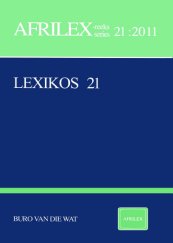Defining Formats and Corpus-based Examples in the General Ndebele Dictionary, Isichazamazwi SeSiNdebele
In this article the writer evaluates the defining formats that were used in defining headwords in the first monolingual General Ndebele Dictionary, Isichazamazwi SesiNdebele (ISN). The emphasis in the ISN was on the concept of user-friendliness. The article establishes that defining formats in the ISN are a judicious mixture mainly of the defining formats of the Collins Birmingham University International Language Database (COBUILD) and of what has been referred to as traditional formats. The first part of this article is an analysis of the decisions taken by the ISN editors in formulating their defining formats. It assesses the COBUILD defining principle vis-à-vis its application in defining headwords in the ISN and the impact of this principle on the user-friendliness of the dictionary. It further discusses other formats, including the decision to retain traditional defining formats for defining headwords. One of the traditional defining styles agreed upon was that the editors were to give the hypernym in the case of semantic sets, and then to identify the concept being defined by specifying aspects that distinguish it from others of its type. The second part of the article evaluates the importance and use of the corpus in providing both definitions and examples for the ISN. However, it is further argued that since a corpus has to be “representative” in terms of size in order to be appropriately used as basis for such corpus-based dictionaries, the ISN editors whose corpus was relatively small, could not avoid relying on intuitive knowledge in constructing some examples.

